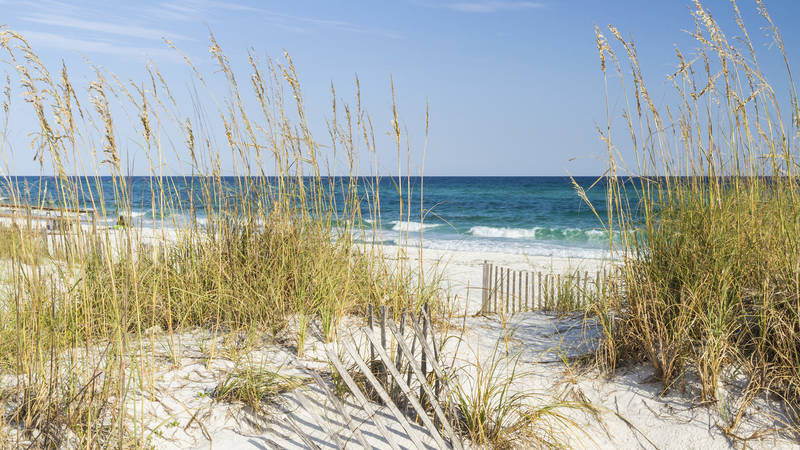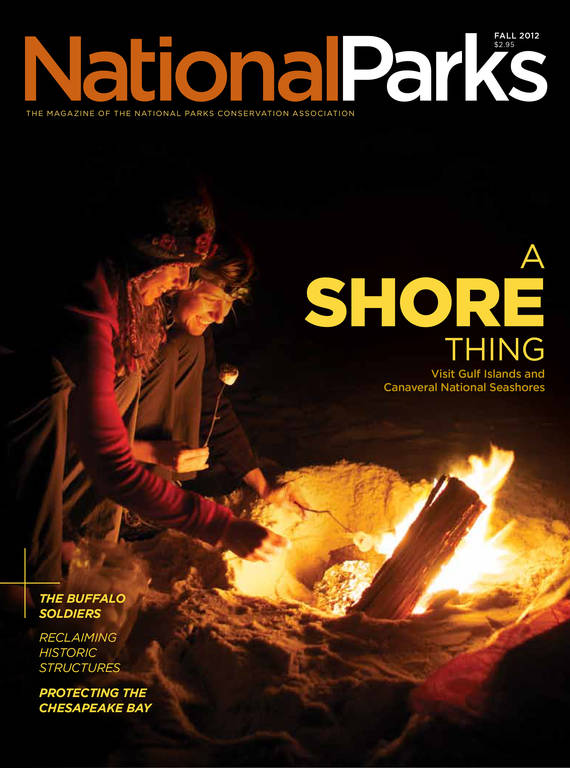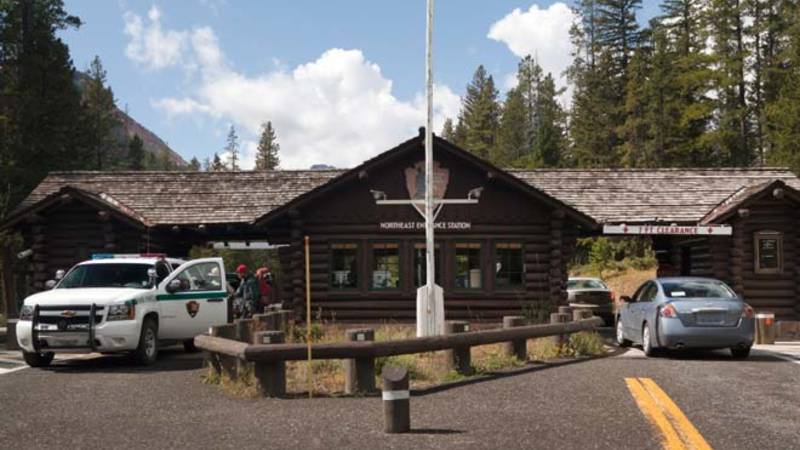Fall 2012
Coast to Coast
From Mississippi’s Gulf Coast beaches to Florida’s Atlantic shores, these national parks have more to offer than white sands and saltwater.
If you spend the night at the main campground for the Gulf Islands National Seashore, brace yourself for a morning that begins with the traditional military bugle call, “Reveille.” It is not what you’d expect on a typical day at the beach, but this is no average beach.
Gulf Islands National Seashore includes chunks of Florida’s panhandle and Mississippi’s barrier islands. It encompasses some of the best and longest undeveloped coastal stretches in the country, complete with white sandy beaches that make frigid Northerners swoon. But the inspiration for the park’s formation in 1971 was as much about protecting examples of every type of coastal military defense system ever built in the United States as it was about relaxation. Today, the entire park serves as a handy place to point those who make the common mistake of thinking that Florida is short on history.
Gulf Islands: Florida
TRAVEL ESSENTIALS
The Florida side includes three forts that look out over the thin ribbon of water that is the only inlet to Pensacola’s massive harbor; a fourth fort rests farther inland. The government built the structures after the War of 1812 as part of a push to protect the country’s main harbors against any would-be invaders. Pensacola was especially important: In addition to being a major commerce center, as of 1825, it was also home to a major Navy shipyard—the only one at the time on the entire Gulf of Mexico.
The park’s flagship is Fort Pickens, where reminders of the former military presence are everywhere. Here on Santa Rosa Island, just south of Pensacola, you can still wander the scenic brick halls of the fort where the military once held famed Apache leader Geronimo. Some portions are crumbling, but much remains intact.
Surprisingly, no foreign enemies ever challenged the fort, only internal ones. The first time it saw action was during the Civil War when the Confederates briefly took control of the other Pensacola forts and the Union held Fort Pickens with some help from the Navy. It was an ironic battle given that Col. William Chase led the attack against Fort Pickens—the same man who had overseen its construction by slave labor.
But Fort Pickens didn’t fade with cannon fire. Military technology advanced, and the fort did, too, as the government constructed new concrete structures capable of repelling more powerful cannons and eventually modern artillery.
Battery Langdon, one of numerous fortifications you can wander, now looks like a kid’s dream fort, buried beneath a man-made hill with sealed entryways hidden behind brush and unseen from the road or beach. These batteries grew through both world wars. By World War II the 12-inch guns here could hurl rounds 17 miles offshore, and they were so powerful the concussion of a single report once split an artilleryman’s pants. Though many soldiers trained here and stood watch for U-boats, ships, and planes, none ever came close enough for battle. Eventually guided missiles, atomic bombs, and the like came along to force new military strategies that left places like this obsolete.
Modern development in this area is so sparse that it’s easy to stand at such sites and imagine what it would have been like to be there during wartime, straining to spot signs of an approaching enemy.
Once you’ve had your fill of military history and scenic human handiwork, choose one of several beach access points through the sea oats to those wide, white sandy beaches. By moonlight the soft, wind-sculpted dunes look almost like snowdrifts.
Across the narrow inlet at Perdido Key, only a few scattered bunkers remain from the military days. Instead, on this side one of the most attractive features is the potential for seclusion, which is limited only by your willingness to walk—the road ends five miles before the beach does. Naturally, most visitors set up their chairs and umbrellas near boardwalks, but head east far enough and you might even be alone. For those willing to make the slog, the Park Service allows camping right on the soft sand, as long as you make it a half-mile beyond the end of the road.
Gulf Islands: Mississippi

Gulf Islands National Seashore
The 12 separate units of this park protect a series of barrier islands off of the Gulf Coast and offer a little bit of everything, including snorkeling, fishing and bicycling…
See more ›Though the Florida side is the more heavily visited, Gulf Islands also includes several Mississippi barrier islands south of mainland beaches like Gulfport and Biloxi. Two of these outposts, Petit Bois (pronounced “petty boy”) and Horn, are both congressionally designated wilderness areas.
As a result, these islands’ 20-plus miles of beaches are beautifully void of just about anything but pine trees, white sand, and wildlife like bald eagles, black skimmers, and ghost crabs. In the islands’ interiors, a rodent of unusual size known as a nutria might even cross your path. If the weather conditions are calm enough, you’ll take these wonders in while looking out across waters that are a nearly tropical turquoise.
You can reach the wilderness islands only by private boat, but a public ferry runs out to nearby West Ship Island twice a day in the Summer and once a day in the Fall. The site features a long boardwalk, bathrooms, a snack bar, and a beach rental shack. But the island’s most striking feature is another red-brick gem called Fort Massachusetts. It is surreal to see such a structure 10 miles from the mainland, seemingly resting on shifting sands, though it has withstood the onslaughts of countless hurricanes, including a serious beating from Katrina in 2005.
The Mississippi islands were some of the hardest hit by the 2010 Deepwater Horizon disaster in the Gulf, and plenty of oil washed onto beaches on the Florida side of Gulf Islands as well. Now, more than two years after the oil stopped flowing, tar balls from the spill still wash ashore. But ongoing cleanup efforts are extensive enough on the more popular beaches in Gulf Islands such as West Ship and Fort Pickens that most visitors won’t spot a drop. Tar balls remain at remote areas such as Horn, but even there they are mostly scattered and shouldn’t pose problems to visitors.
Canaveral National Seashore
SIDETRIP
Where Gulf Islands National Seashore is a monument to the military past, over on Florida’s east side, the Canaveral National Seashore offers an homage to more modern pursuits. This 24-mile stretch of scenic lagoon and beaches owes its existence to the space program, which bought up huge chunks of land around Kennedy Space Center.
Just about anywhere you go in the south end of the park, a beautiful stretch east of Titusville called Playalinda Beach, is within view of NASA’s gargantuan spaceship garage called the Vehicle Assembly Building. The shuttle launch pads are so close that during launches officials had to close the entire area. Though the shuttle program has ended, there are still plenty of commercial satellites and other launches, but these generally blast from pads farther away, so closings are rare.
If your ideal day at the beach involves neon-splattered trinket shops and hot dog vendors, then it’s best to look elsewhere. At Playalinda, you’ll find plenty of parking areas to spread out the crowds, with no buildings visible but NASA’s, and even those are distant. You can walk as far north beyond the last parking area as you fancy, but you’ll need to ask for a backcountry pass at the entry gate.
Be warned: For decades the beach just beyond the last parking area has been a de facto clothing optional zone. Technically, nudity on the beach is illegal, but only by local ordinance, and local police rarely make it out this far. There’s no federal law against the nudity, so park rangers can’t ticket. Hence, a few bathers of all ages have usually lost their swimsuits. Stay away from that last parking area, and it won’t be an issue.
Hang a left on your way to the beach on one of the accessible dirt roads and you’ll find some of Florida’s best birding grounds. Herons, hawks, and roseate spoonbills, among countless other species, are easy to spot.
You can also access Canaveral from a north area known as Apollo Beach, just below New Smyrna Beach. Each end of the park has its own boat ramp, and paddling the scenic Mosquito Lagoon that stretches the length between is much more pleasant than its name implies. Look for manatees or the occasional alligator as you head toward mangrove passages or palm-fringed beaches.
The south end of the lagoon is more open; the northern end is a maze of mangrove islands. With few exceptions the lagoon is shallow, making it ideal for wading, kayaking, and canoeing, and it’s a world-class destination for reeling in redfish, snook, and trout. Surfcasting for pompano or whiting is an alternative for those who prefer to keep their feet in the sand.
Camping is available only at the Apollo side, with two sites right on the beach and 14 others scattered around the lagoon’s mangroves.

National Parks
You can read this and other stories about history, nature, culture, art, conservation, travel, science and more in National Parks magazine. Your tax-deductible membership donation of $25 or more entitles…
See more ›Most visitors will make the mistake of missing Seminole Rest, because it’s outside the main park areas and a little harder to find. The showpiece here is a three-story house with a tin walk-around balcony and a truly stunning all-yellow pine interior. The owners moved the house here in 1888. Everyone in the small town of Oak Hill called this English minister and his wife Lord and Lady Turner, though the titles were just nicknames. Official tours start every Sunday at 2 p.m., but you’re sure to find a ranger happy to fill you in on the home’s history anytime it’s open.
While admiring the house and lagoon views, be sure to look straight down. You’ll be standing on a 13-foot-high mound of quahog clamshells. This local delicacy was a staple for the Timucua Indians who lived in these parts for thousands of years before Europeans came along. As they ate, they piled their shells. Such Indian mounds are scattered throughout the state. Many, especially in this area, got scooped up during the quest to build a railroad all the way to Key West, but the Turners quite literally stood their ground here when the diggers came asking. Between the Turners and the Timucua, there’s a fine glimpse here of what is in fact a rich Florida history. And a glance across the lagoon to Apollo Beach—about three miles as the gator swims—serves as a fitting reminder of how much Florida still has to offer.
About the author
-
 Mark Schrope Contributor
Mark Schrope ContributorMark Schrope is a freelance writer living in Florida, where he is finishing a book about the science and environmental impacts of the Deepwater Horizon disaster. His work appears in publications such as Nature and The Washington Post.


